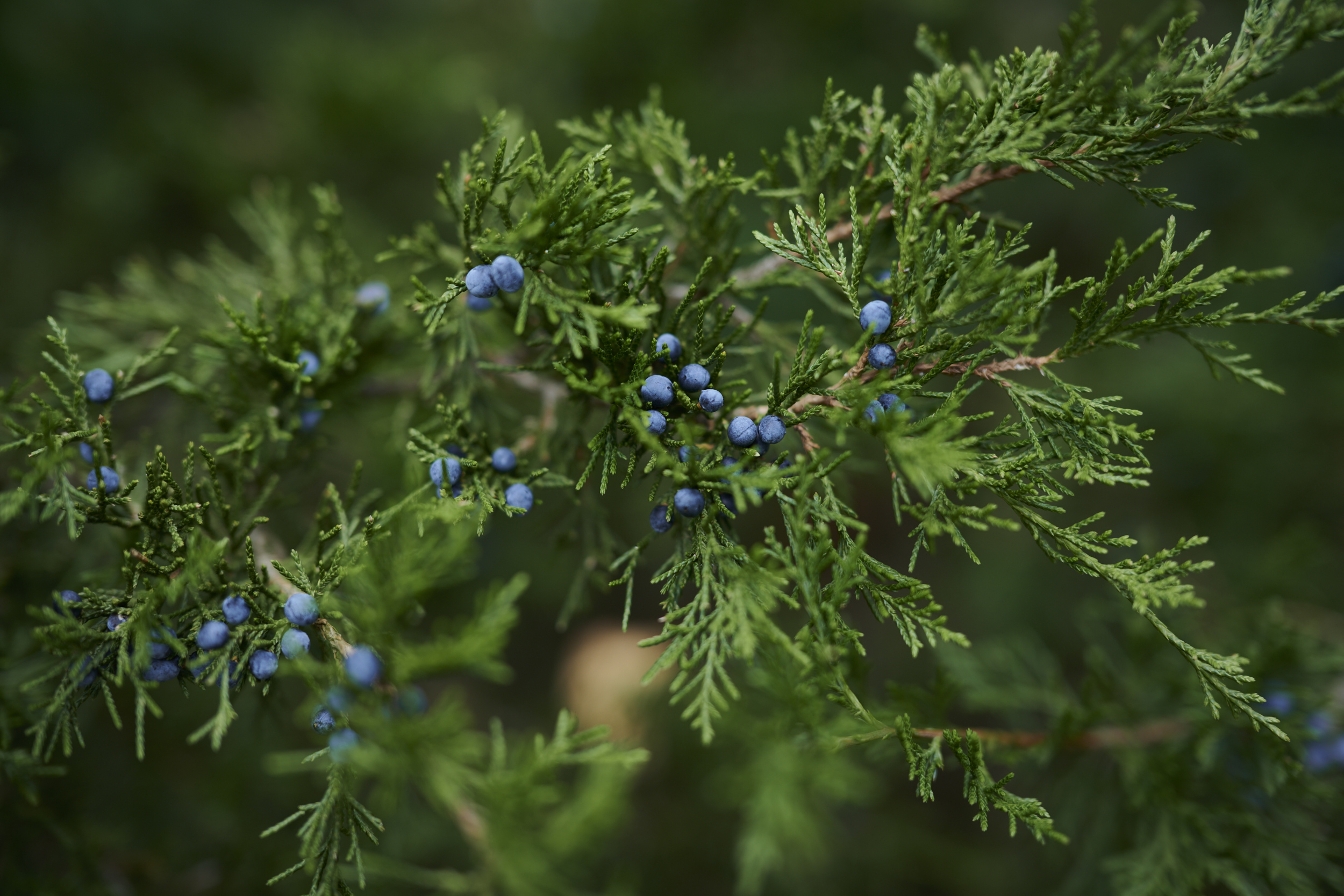
Viriditas: Musings on Magical Plants
Juniperus spp.
By Margaux Crump
Sign up for our monthly newsletter!
As the rusty golden hues of autumn depart and winter begin to drift across the landscape, evergreens color my vision. Juniper in particular, encrusted with its silvery-blue cascade of berries, sparkles this time of year. In the winter, I feel especially attuned to the presence of its spiky leaves and coniferous ‘berries.’ Early this November, as I drove from Massachusetts to Texas, it seemed as though juniper was everywhere. And in many ways, it is. From columnar trees to weeping shrubs, the genus Juniperus has a vast range across Asia, Europe, North and South America, and Africa. It’s abundant, hardy, and vigorous, thriving in conditions from lowland bogs to alpine tundra.
Juniper and I are old friends. The window of my childhood bedroom was veiled by a large Juniperus virginiana and I would often watch the world unfold within its branches: the green anoles shifting from brown to brilliant chartreuse, the flittering juniper hairstreak butterflies, the orange house tiger napping beneath the canopy. Junipers are also alive with birds. Of course, the visitors shift from season to season and by location, but juniper often hums with mockingbirds, robins, and cedar waxwings, who love feasting upon the cones.
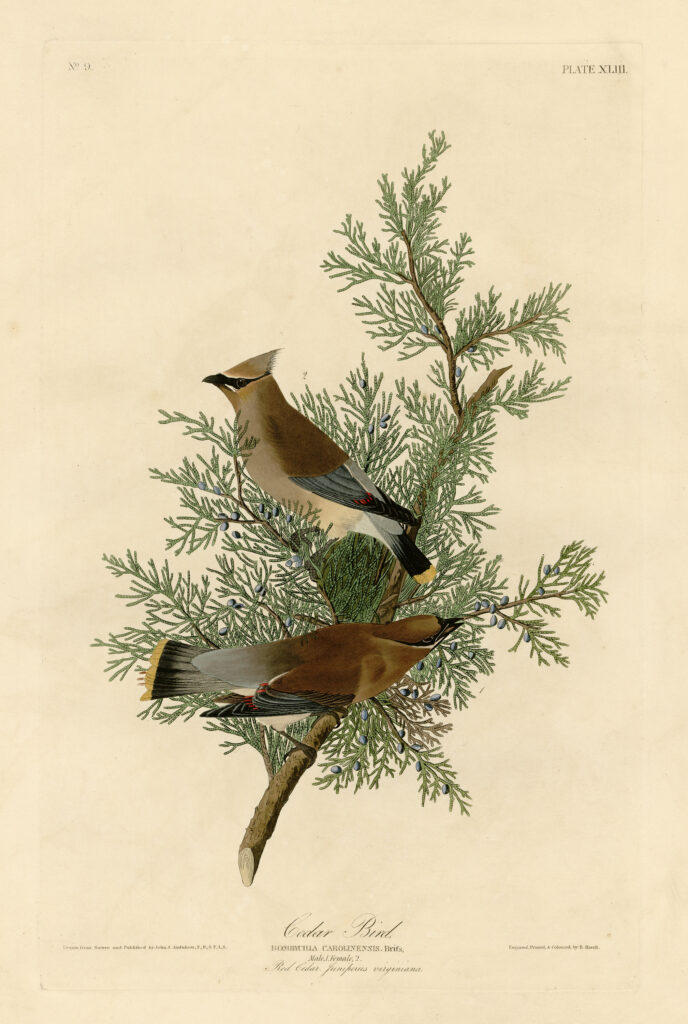
Cedar Waxwing in Juniperus virginiana
Cedar Bird. Plate XLIII
John James Audubon
1827-1838
I too love juniper cones: rolling the berries between my fingers, watching their ephemeral silver dust disappear, releasing their effervescent woody aroma into the air. I like to commune with juniper this way. There’s something sacred in this small act of rolling and releasing. Bringing the berries close to my nose and inhaling their scent lifts me into a tiny moment of transcendence.
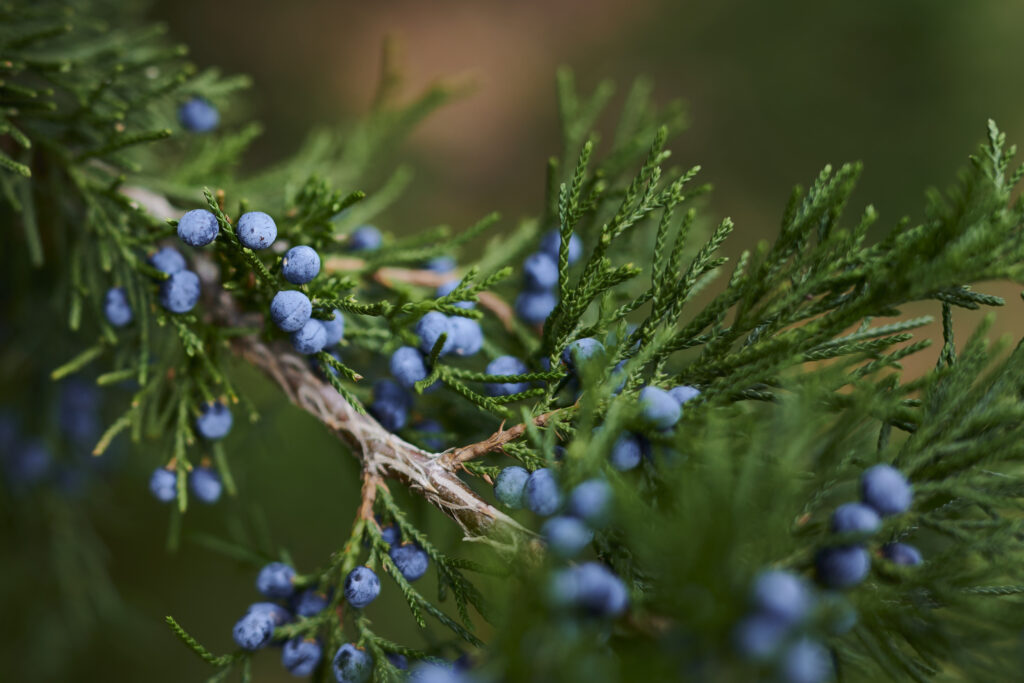
Juniperus virginiana
Juniper has a long association with the sacred. Pliny tells us that the temple to Diana in Saguntum, Spain had juniper beams. 1 In Tibet, the Reting monastery sits within a forest of juniper trees, which according to legend form a sacred landscape that is protected to this day. 2 Similarly, in Welsh folklore, if you cut down a juniper tree, you will surely die within the year. 3 From predynastic to Greco-Roman Egypt, juniper berries have been discovered in burials, 4 sometimes placed directly on the dead. 5 In the Greek Magical Papyri, a body of papyri from Greco-Roman Egypt, juniper is frequently listed as a material used for carving altars and shrines as well as for casting spells. For instance, in a slander spell to Hekate/Selene (PGM IV. 2622-2707), the practitioner is instructed to:
Take a magnet that is breathing and fashion it in the form of a heart, and let there be engraved on it Hekate lying about the heart, like a little crescent. Then carve the twenty-lettered spell that is all vowels, / and wear it around your body. The following name is what is written: ‘AEYŌ ĒIE ŌA EŌĒ EŌA ŌI EŌI.’
For this spell is completely capable of everything. But perform this ritual in a holy manner, not frequently / or lightly, especially to Selene. At any rate, burn upon pieces of juniper wood an offering of Cretan storax and begin the spell. 6
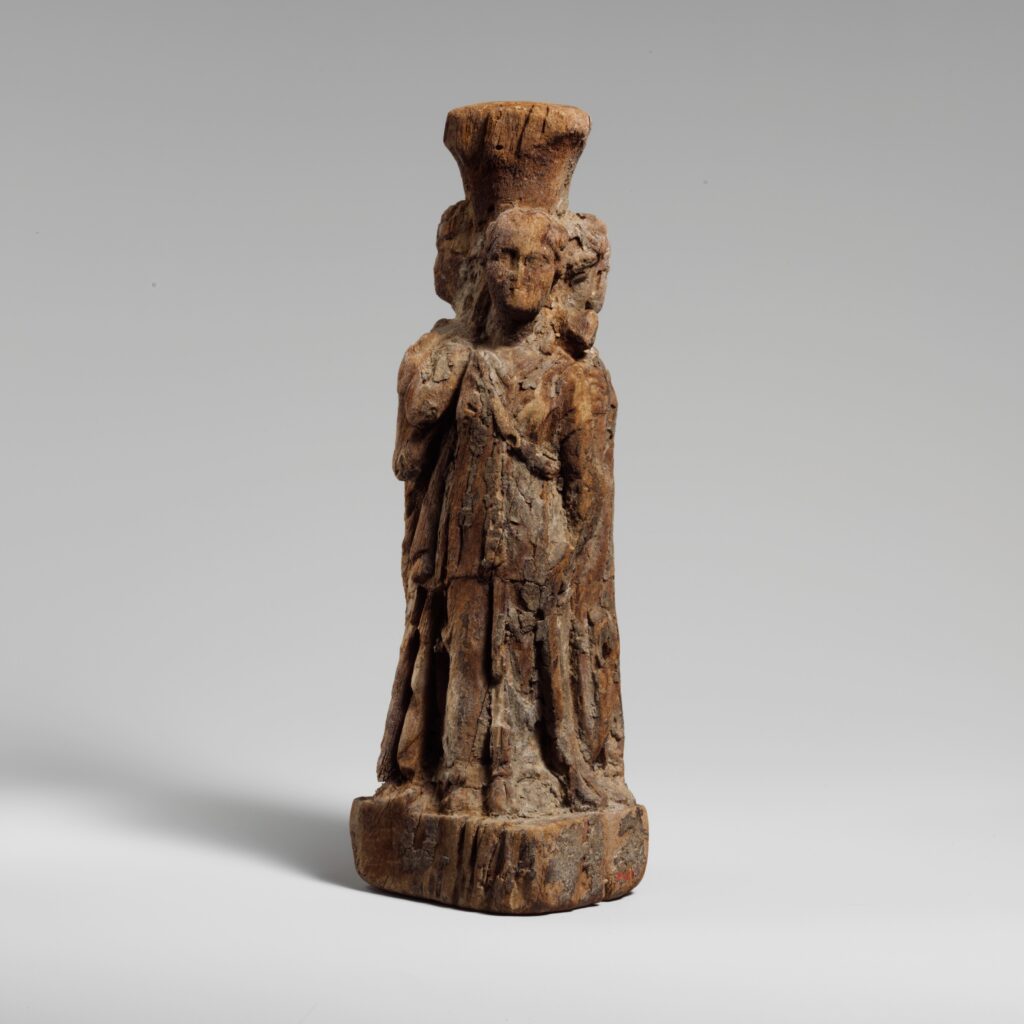
Wood statuette of Hekate, Egyptian, Ptolemaic, 304–30 BCE, carved out of juniper wood.
The Metropolitan Museum of Art, New York
Purchase, Joseph Pulitzer Bequest, 1939
Juniper’s association with the sacred is entwined with its powers of purification. Enrique Salmón shares that, “juniper is present at nearly every kind of indigenous ceremony in the Southwest. Prior to entering into the lodge, many sweat leaders will offer the participants a cup of an infusion made from the leaves of juniper. This is said both to purify the body and to produce a better sweat.” 7 Cultures across the globe have used juniper as a form of incense, fumigation, and smoke medicine for thousands of years. In Tibet, juniper incense is helpful for meditation and for accessing deeper and clearer consciousness. 8 In the Scottish practice of saining, juniper is burned to cleanse the home and barn by filling it with great amounts of smoke. 9 This was done to ward off both evil and disease, usually on New Year’s Day, but also the quarter days. According to Scottish folk custom, juniper (iubhar-beinne or mountain yew) “had to be pulled by the roots, with its branches made into four bundles and taken between the five fingers, whilst the incantation was repeated:
I will pull the bounteous yew,
Through the five bent ribs of Christ,
In the name of the Father, the Son, and the Holy Ghost,
Against drowning, danger, and confusion.” 10
The necessity of harvesting juniper by hand—as opposed to cutting tools—is perhaps due to the belief that spirits do not like iron, especially the Sidhe who are important figures in Scottish folklore who must be respected.
Saining with juniper also confers protection, especially on cattle. Likewise German lore tells of juniper driving monsters away from cows and horses. 11 During the Tibetan ritual called lhasang, juniper is burned on mountaintops as an offering to deities in return for protection. 12 While in Italy, holes or fissures in houses are brushed with Juniper to prevent evil spirits from entering and boughs are suspended above doorways because “witches who see the Juniper are seized with an irresistible mania to count all its small leaves, which, however, are so numerous that they are sure to make a mistake in counting, and, becoming impatient, go away for fear of being surprised and recognised.” 13 The Navajo consider juniper a sacred medicine and string dried juniper berries together as ghost beads to ward off evil spirits. 14 Throughout Classical Antiquity, juniper is also understood to dispel serpentine threats. Dioscorides notes in De Materia Medica that juniper fumes are useful for driving away snakes. 15 Similarly in Egypt, juniper resin was applied to papyrus to deter hungry bookworms, 16 and in the Ebers Papyrus (EB 85), juniper is said to treat intestinal tapeworms. 17 Most dramatically, Greek mythology recounts how Medea, with divine support from Hekate, protects Jason from a giant serpent by applying a magical sleeping potion into its eyes using a freshly cut sprig of juniper. 18
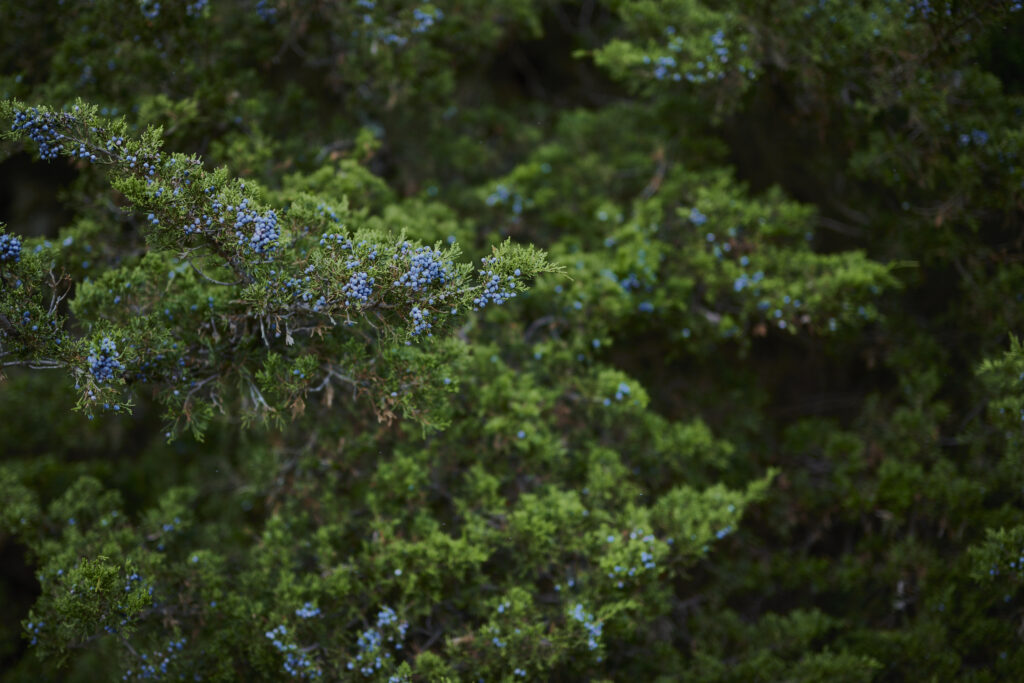
Juniperus virginiana
Historically, different communities work with different species of juniper. Considered hot and dry, J. communis is perhaps the most well known and is prized for its antiseptic, antioxidant, anti- inflammatory, and anti-cancer effects. It is a well loved herb used in many traditional medicinal practices. Ibn Sina recommended J. communis as a wound healing agent and abortifacient; 19 Nicholas Culpeper prescribed it as a diuretic and for digestion; 20 while Hildegard von Bingen provided the following recipe for juniper curative wine:
Take its fruit, cook it in water, strain this water through a cloth. To this water add honey and a bit of vinegar and licorice, and less ginger than licorice. Cook it again, and place it in a little bag, and make a spiced wine. Drink it often, whether fasting, or having eaten. It diminishes and mitigates pain in the chest, lungs, and liver. 21
The peoples of the Southwest have long worked with junipers including J. monosperma, J. osteosperma, and J. deppeana. Salmón notes a diffusion of the leaves is used to treat skin and urinary tract infections and provides relief from arthritic pain and rheumatism. 22 J. recurva is a high altitude juniper loved by the people of the Himalayas and J. tibetica makes up the forest that surrounds the aforementioned Reting Monastery. 23 Whereas the prickly J. oxycedrus is likely the species referred to in the Ebers Papyrus as a vermifuge. Yet for all their celebrated uses, it’s also important to note that some species of juniper are considered toxic and they should be worked with cautiously.
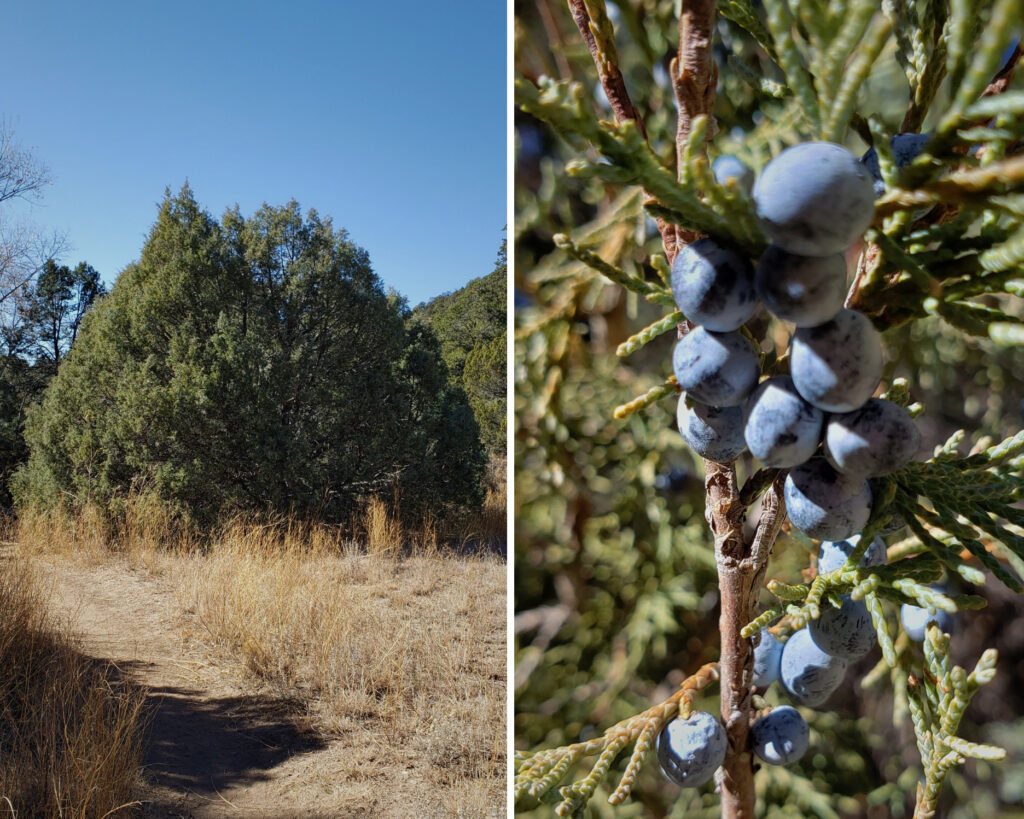
A juniper in New Mexico. Possibly Juniperus virginiana. Photo: Carolyn Florek
One of my favorite figures from juniper folklore is Frau Wacholder, the German spirit of juniper. When goods are stolen, it is Frau Wacholder who is petitioned to compel their return. It is said that the ritual takes place beneath a juniper with a branch bent to the earth. 24 Perhaps juniper is a plant who watches, who sees, who knows. The German word wach, means awake. And the Brothers Grimm agree. In their notes for The Juniper Tree, they explain that the Wacholder “is a tree which rejuvenates, and is awake so far as is implied by quick, active, vivus, living.” 25
In my own practice, I bundle and burn juniper for cleansing and protection. Around the time of the winter solstice, I carefully harvest a few small juniper branches by hand. After bringing the branches indoors, I bind them together at one end with red thread and place them above my doorway. I like to imagine and entrust juniper as guardian of the threshold. My tradition is to burn the previous year’s bundle as a way to honor my ancestors and sain my house for the new year. As the many historical uses and traditions attest, there are boundless ways to incorporate juniper into your home, rituals, and wellness. If you’re not sure how, perhaps take some time to notice the juniper around you—where it grows, how it smells, how it feels—Frau Wacholder may be watching and she just might share some ideas.
- Pliny the Elder, The Natural History of Pliny, John Bostock and H.T. Riley, trans, (London: Taylor and Francis, 1855) Book XVI ch. 79, https://www.gutenberg.org/files/57493/57493-h/57493-h.htm ↩︎
- Nathalie Bazin, “Fragrant Ritual Offerings in the Art of Tibetan Buddhism,” Journal of the Royal Asiatic Society 23, no. 1 (2013): 31–38. http://www.jstor.org/stable/43307642. ↩︎
- Tredyffrin Easttown Historical Society, History Quarterly Digital Archives, April 1984 Volume 22 Number 2, Pages 55–66,
https://www.tehistory.org/hqda/html/v22/v22n2p055.html. ↩︎ - Margaret Serpico, with a contribution by Raymond White, “Resins, Ambers, and Bitumen,” in Ancient Egyptian Materials and Technology, eds. Paul T. Nicholson and Ian Shaw (Cambridge: Cambridge University Press, 2000), 433. ↩︎
- Lösch, Sandra & Hower-Tilmann, Estelle & Zink, Albert. (2013). Mummies and skeletons from the Coptic monastery complex Deirel-Bachit in Thebes-West, Egypt. Anthropol Anz. 70. 27-41. 10.1127/0003-5548/2012/0218. ↩︎
- Hans Dieter Betz, ed. The Greek Magical Papyri in Translation, Including the Demotic Spells, (Chicago: University of Chicago
Press, 1986) 86–8. ↩︎ - Enrique Salmón, Iwigara: American Indian Ethnobotanical Traditions and Science, (Portland: Timber Press, 2020) 117. ↩︎
- Nathalie Bazin, “Fragrant Ritual Offerings in the Art of Tibetan Buddhism,” Journal of the Royal Asiatic Society 23, no. 1 (2013): 31–8. http://www.jstor.org/stable/43307642. ↩︎
- F. Marian McNeill, The Silver Bough, Volume 3, (Glasgow: Stuart Titles, 1990) 113–114. ↩︎
- F. Marian McNeill, The Silver Bough, Volume 1, (Glasgow: William Maclellan, 1957) 81. ↩︎
- Folkard, Plant Lore, 395–7. ↩︎
- Bazin, Fragrant Ritual Offerings, 31–8. ↩︎
- Richard Folkard, Plant Lore, Legends, and Lyrics : Embracing the Myths, Traditions, Superstitions, and Folk-lore of the Plant
Kingdom, (London: S. Low, Marston, Searle, and Rivington, 1884) 395–7. ↩︎ - Salmón, Iwigara, 116–17. ↩︎
- Dioscorides Pedanius, T. A. Osbaldeston, and R. P. A. Wood, De Materia Medica: Being an Herbal with Many Other Medicinal
Materials: Written in Greek in the First Century of the Common Era: a New Indexed Version in Modern English (Johannesburg:
IBIDIS, 2000), 101–2. ↩︎ - Bridget Leach and John Tait, “Papyrus,” in Ancient Egyptian Materials and Technology, eds. Paul T. Nicholson and Ian Shaw
(Cambridge: Cambridge University Press, 2000), 240. ↩︎ - Paul Ghalioungui, The Ebers Papyrus: A New English Translation, Commentaries, and Glossaries, (Cairo: Academy of Scientific Research and Technology, 1987) 29. ↩︎
- Apollonius Rhodius, Argonautica 4. 121 ff ↩︎
- Ibn-Sina, Canon of Medicine Book II: Materia Medica, trans. Department of Islamic Studies Hamdard University. (New Dheli:
Jamia Hamdard Printing Press, 1998), accessed Nov 1, 2023,
https://www.naimh.com/_files/ugd/ee530d_32edca193e5e4e039a0a2e27171c2a65.pdf. ↩︎ - Culpeper, Nicholas. Culpeper’s Complete Herbal & English Physician. Bedford, MA: Applewood Books, 2007. First published 1653. ↩︎
- Hildegard. Hildegard Von Bingen’s Physica: The Complete English Translation of Her Classic Work on Health and Healing, trans. Priscilla Throop. Rochester, VT: Healing Arts Press, 1998. ↩︎
- Salmón, Iwigara,117. ↩︎
- Bazin, “Fragrant Ritual Offerings, 31–8. ↩︎
- Folkard, Plant Lore, 395–7. ↩︎
- Jacob and Wilhelm Grimm, Grimm’s Household Tales, with the author’s notes, trans. and ed. Margaret Hunt, (London: George
Bell And Sons, 1884) 399. ↩︎
Margaux Crump is a gardener and interdisciplinary artist exploring the entanglements between ecology, spirituality, and power. She is currently investigating the phenomena of unseen worlds, from the microscopic to the parallel mythic realms that surround us. Follow her on instagram @margauxcrump
Plantings
Issue 30 – December 2023
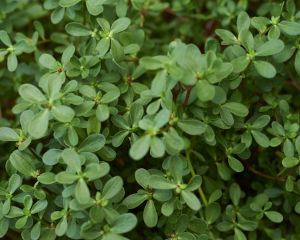
Viriditas: Musings on Magical Plants: Portulaca oleracea
By Margaux Crump
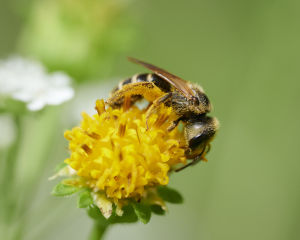
Proboscis, Pollen, and the Rapture of Interspecies Intimacy
By Jake Eshelman

The Greening of Milan: Porta Nuova and Vertical Forest
By Gayil Nalls

Overshooting Earth’s Boundaries: An Interview with Bill Rees
By Rachel Donald
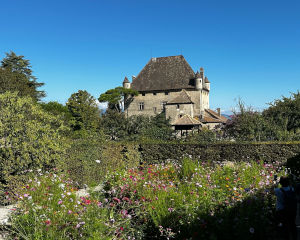
The Garden of the Five Senses
By Gayil Nalls

Eat More Plants Recipes:
Le Botaniste’s Fennel, Tomato, and Red Pepper Pasta Sauce

As Ireland transitions from the rich, smoky scent of peat-burning to a more sustainable future, its olfactory heritage is evolving. What will become the next iconic aromatic symbol of Ireland?
Click to watch the documentary trailer.


